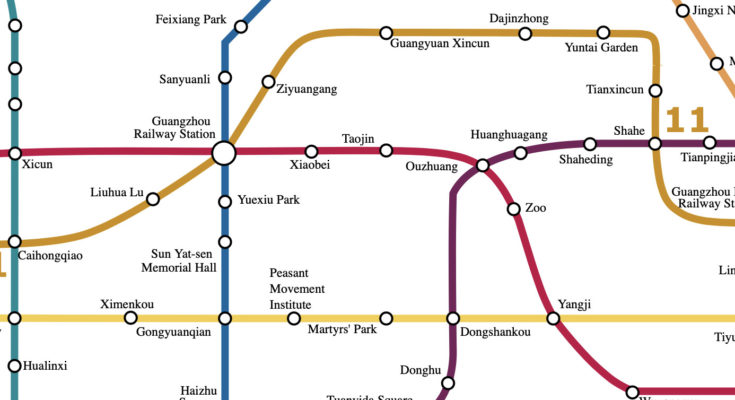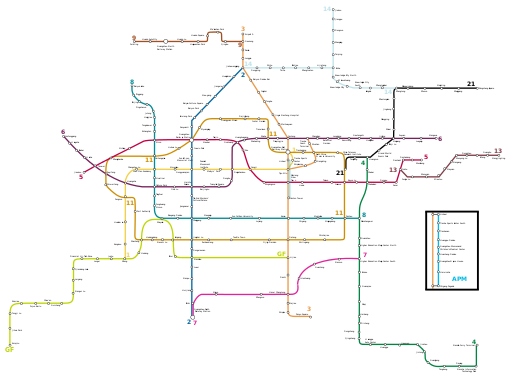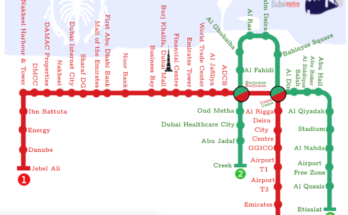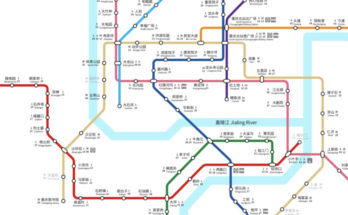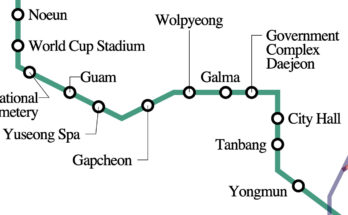This underground rapid transit system is the brain child of Chen Yu who was the governor of the province during 1957-1967. The system has been in discussion from early 1960 onwards. The plan was brought on the table twice over the years, however, was rejected both the time due to financial and technical constraints. Moreover, authorities who surveyed the geological nature of the land opined that the ground is not suitable for construction of an underground metro system.
Finally, after much discussion and planning, Chen Yu and Tao Zhu, the former governor of the province, pushed forward a plan to build a tunnel as part of war time evacuation strategy. Looking at the prospect of such a tunnel which can later be used for post-war metro development, the central government set the motion to have this plan implemented.
Though the construction of line 1, east-while lane connecting Xichang to Dongshan, started in 1984 and the metro system began operation on 28 June 1997, Guangzhou metro system achieved its current stage only after the rapid expansion plans that were put into place during the 2000s.
As of 2013, the Guangzhou metro system has 9 lines that connect a total of 164 stations. Guangzhou metro is state-owned and operated by the Guangzhou Metro Corporation. As per statistics in 2013, on an average 8.61 million passengers use this metro system for daily commute; annually, the figure comes to 2.054 billion passengers.
Contents
Lines and stations
A major part of the metro system connect urban areas of the province. Line 7, line 9 and line 13 are under planning to be added to the existing network. Moreover, extensions to line 6 and line 8 are also under construction. In order to help the passengers distinguish, each lines are color-coded.
- Line 1: Opened in 1997. Connecting Xilang and Guangzhou east railway station. Length – 18.5km. Number of stations – 16 underground stations.
- Line 2: Opened in 2002. Connecting Jiahewanggang and Guangzhou south railway station. Length – 31.4km. Number of stations – 24
- Line 3: Opened in 2005. Connecting Airport South and Tiyu Xilu. Length – 67.3km. Number of stations – 28
- Line 4: Opened in 2005. Connecting Huangcun and Jinzhou. Length – 43.7km. Number of stations – 16
- Line 5: Opened in 2009. Connecting Jiaokou and Wenchong. Length – 31.9km. Number of stations – 24
- Line 6: Opened in 2013. Connecting Xunfenggang and Changban. Length – 24.5km: Number of stations – 22
- Line 8: Opened in 2003. Connecting Fenghuang Xincun and Wanshengwei. Length – 14.8km. Number of stations – 13
- Guangfo line: Opened in 2010. Connecting Guangzhou City and Foshan City. Length – 20.4km. Number of stations – 14
- APM line: Opened in 2010. Connecting Linhexi and Canton Tower. Length – 3.9km. Number of stations – 9
Hours of operation
Passengers can use the metro during 6 am to 12 pm, seven days a week.
Fares and tickets
The fare depends on distance, ranging on an average from 2 Yuan to 14 Yuan. Guangzhou metro system also provides group discounts, up to 10%, provided the number of travelers is 30 or more. The metro corporation also provides certain contactless smart card Lingnan pass. Passengers with this card can avail huge discounts: 5% for the first 15 journeys, and 40% for all subsequent journeys every month.
Single day journey ticket
Passengers can avail a single day journey ticket which is valid only for the date of purchase. The fare varies depending on the distance travelled; for a distance of 0-4 km, the standard fare of a single journey ticket is 2 Yuan. There will be addition to this fare after every 4 km, 6 km and 12 km.
The rule mandates that the journey should not be more than one day; if not, the passenger will be charged the fare for the longest journey. Vending machines/kiosks are available at all the stations that Guangzhou metro system. The ticket contains radio frequency tokens that the sensors on the ticket barriers detect during entry and exit.
Senior citizen pass
With this pass a senior citizen (60+ years of age) can avail 50% discount on travel.
Student pass
School-going children can avail discount on their daily travel with the student pass. This pass is available for students of primary, secondary and vocational schools. This card entitles them to a discount of 50%.
Day passes
Guangzhou metro system also provides daily passes with unlimited rides on the metro system; however, there is a validity period. A one day pass can be purchased for 20 Yuan, valid for a duration of 24 hours. A pass for 50 Yuan is valid for 72 hours or three consecutive days.
Park and Ride
Guangzhou metro offers park and ride facilities at selected metro stations.
Dos and Don’ts. Tips
Consumption of alcohol and tobacco is prohibited inside the metro system. Eatables are also not allowed inside the metro system. Inflammable substances and any kind of chemical compounds that has the capacity to ignite or explode are strictly banned in all the stations. People who do not comply can expect to be behind bars within no time.
Curious facts
Over the years the Guangzhou metro corporation was subjected to many heated arguments in media and among the public.
When the metro came up with the idea to give out free rides to the family members of its employees in 1997, the policy was subjected to much public scrutiny. The validity of such an option was questioned by people from all walks of life. Newspapers blamed the metro for exploiting public resources for personal benefits. Later, the corporation revealed the beneficiaries of such a policy included only spouses and children under 18.
In 2009, an alleged attempt fraud was reported in connection with two technicians who submitted inspection report on couple of cases.
In 2010, some discrepancies in quality standards of two concrete structures in line 3 was reported. The possible consequences of such low quality construction included blockage of ground water drains, passenger and metro car safety.
